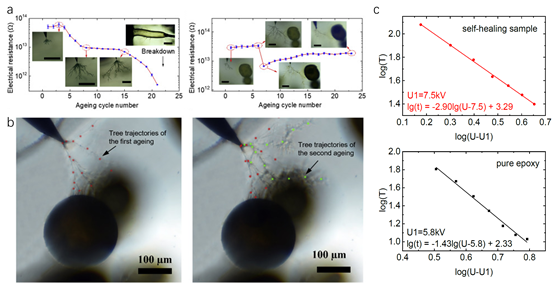On February 6, 2020, Professor He Jinliang, Associate Professor Li Qi and their collaborators of EEA, Tsinghua University published a research paper entitled "Autonomous Self-Healing of Electrical Degradation in Dielectric Polymers Using In Situ Electroluminescence" in Maer magazine. This work realizes the healing and insulation performance restoring of large-size thermosetting insulation materials from electrical tree damage, and provides a new idea for greatly improving the insulation life and reliability of power devices and electronic equipment. Maer magazine published an invited review of "Autonomous Self-Healing to Combat Insulation Failure".
Electrical tree damage is the most common electrical degradation in polymer insulation materials, which is generally considered to be the main cause of insulation performance deterioration and breakdown, and seriously threatening the service life and reliability of power devices and electronic elements. In recent years, research progress on self-healing materials have been disclosed in many reported, but most of them can only deal with mechanical damage and few on electrical damage of solid insulating materials. The multi-scale damage forms of electrical damage (such as electrical tree), the complex chemical degradation process accompanied by insulation degradation and the harsh working environment of high voltage insulating materials (high temperature and high electric field strength) bring a huge challenge to the design, research and development of autonomous self-healing insulating materials.
In this study, the electroluminescence accompanying the electrical degradation was innovatively used as the trigger source of the curing solution (without the intervention of any external energy) to realize the completely spontaneous healing. The targeted attraction of microcapsules to the development path of electrical branches was realized by using the non-uniformity of dielectric constant of the healing solution and polymer matrix, and the negative effect of solidifying catalyst and high fluid content on electrical insulation performance in the traditional microcapsule self-healing system were effectively solved by calculating and optimizing the content of microcapsules. In order to prevent the healing solution from curing in advance due to electroluminescence in the microcapsule, a composite microcapsule shell with UV shielding function was synthesized. As the microcapsule only forms micron holes in the shell when the electric branch hits the microcapsule, the microcapsule can provide the healing liquid for multiple electric branch healing and maintain a light shielding function.

Fig. 1: Schematic diagram of self-healing principle. (A) Self-healing process of microcapsules triggered by electroluminescence; (B) Preparation process of microcapsules with UV shielding function
The results of experiments and finite element calculation show that the high dielectric constant healing solution in microcapsules can distort the surrounding electric field distribution, attract the electric tree to grow and realize a targeted healing effect, which greatly improves the healing probability of electric branches. A random growth model was used to calculate the effect of different microcapsule concentrations on the healing probability and the average growth length of electrical branches, and the result showed that 5% of microcapsule doping could reduce the average electrical branch length before triggered healing to less than 400 μm. At this concentration, the breakdown strength of the self-healing composite material is maintained at more than 90% of that of the epoxy resin substrate.

Fig. 2: Calculation result of finite element method and random electrical tree growth model. (a, b) Effect of dielectric constant of microcapsules on electric field distribution and growth path of electrical branches: (a) Low dielectric constant capsules repel electrical branches, (b) High dielectric constant capsules attract electrical branches; (c-e) Calculate the hit probability (d) and average growth length (e) of electrical branches at different concentrations of microcapsules with a random electrical tree growth model
The self-healing material can automatically heal the electrical branch damage in the continuous cyclic aging test, and restore the insulation resistance of the material to the level close to that before degradation. Due to the use of the healing solution with higher insulation performance after curing, the voltage at the appearance of the electrical tree in the healed sample was greatly increased, and the secondarily degraded electrical tree grew in a path away from the healed area of the initial electrical branch damage, thus showing an excellent healing effect. Based on the insulation life curves fitted to the degradation experimental data, the self-healing insulation material showed a higher tree voltage resistance (U1) and a longer insulation life (slope of the curve).

Fig. 3: Assessment on electrical properties of the self-healing material. (a) Insulation resistances of pure epoxy resin (left) and microencapsulate self-healing sample (right) in the cyclic degradation experiment; (b) Electric tree growing paths of the microencapsulate self-healing samples after the initial (left) and secondary (right) degradation experiment; (c) Insulation life curves fitted according to the degradation experimental data and wave model
In recent years, Professor He Jinliang and Associate Professor Li Qi of EEA, Tsinghua University have carried out a series of original research in the field of self-healing dielectric materials. Previously, for thermoplastic insulating materials, the team has realized the targeted healing and electrical insulation restoring of thermoplastic solid insulating materials via the entropy dissipation and migration behaviour of nanoparticles in the polymer in combination with the magnetocaloric effect of superparamagnetic nanoparticles (Nature Nanotech.. 2019, 14, 151–155). Recently, the team has further realized the healing of nano-to-millimeter cracks, perforations and other forms of material failure in thermoplastic polymers, with a favourable universality (Nanoscale, 2020,12, 3605 / 3613, cover paper). This series of research is funded by the State Key Research and Development Program (2018YFE0200100) and the State Key Basic Research and Development Program (2014CB239505). The co-first authors of this paper are doctoral students Gao Lei, Yang Yang and Xie Jiaye of EEA, Tsinghua University. Professor He Jinliang and Associate Professor Li Qi of EEA, Tsinghua University and Professor Wang Qing of Pennsylvania State University are the correspondent authors of this paper. Maer magazine is the flagship journal of materials science of Cell Press, which has been officially published since July 2019. As a sister journal of Cell, Maer publishes transformative research papers on materials science across multi-disciplinary fields.
Article link: https://www.cell.com/matter/fulltext/S2590-2385(19)30348-0

















 News & Events
News & Events